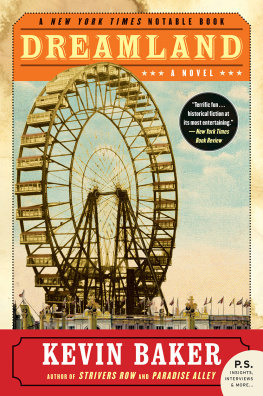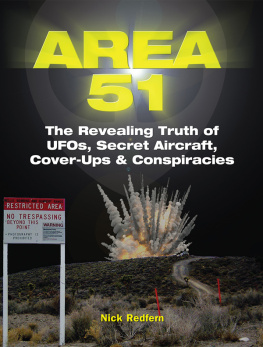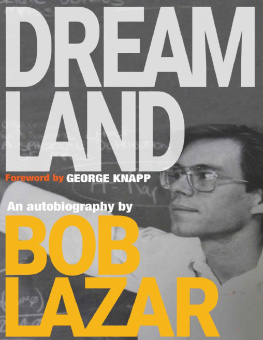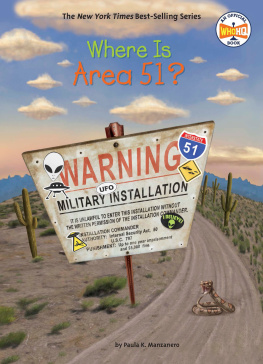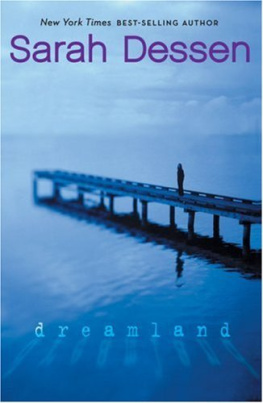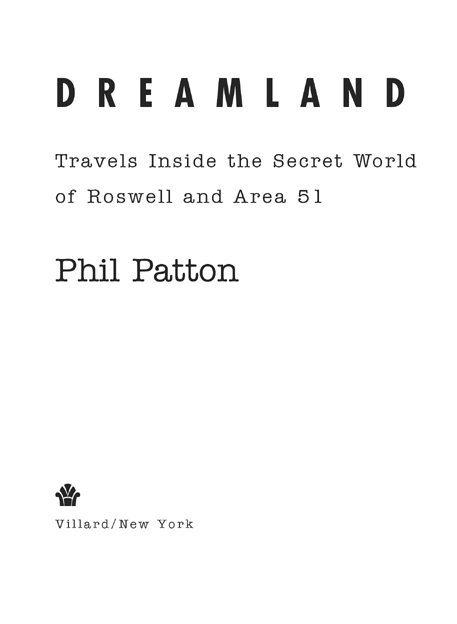PRAISE FOR DREAMLAND
A brilliant book in which nothing is as it seems, while everything has a rational explanation, and yet, even so, the rational is its own sort of Dracula.
J OHN L EONARD , The Nation
Nonfiction matter to the novelistic anti-matter of Don DeLillos recent Underworld, Dreamland is a brilliantly realized tale of the untold, of U.S. secrecy thats been held like a breath and the farce of its being held too long a must-read for dreamers and skeptics alike.
San Francisco Chronicle
A rare literary work from the ascendant culture that mingles technology, popular culture, and science fiction with alienation, suspicion, and disconnection from mainstream media, politics, and government.
J ON K ATZ , HotWired
This eloquent and frequently astounding book takes readers along on an audacious, circuitous exploration of the desert landscape in and around the most secret military bases in the American West, and of the psychological landscape of fantasy, lore and suspicion that surrounds them. Patton has produced the definitive account of this strange corner of the world and of an even stranger corner of the national psyche.
H AL E SPEN , Outside
Patton evokes an idealistic covert fraternity whose paranoia and disinformation seeped beyond the borders of Area 51.
The New York Times Book Review
A psychic probe into the inner nerd of America.
K EVIN K ELLY , author of New Rules of the New Economy
Patton travels beyond the physical location of Area 51 to the psychic location of those who must believe that in the sky exists a world we are not meant to know. A fascinating meditation on delusion and desire, this is an American tale.
Kirkus Reviews
[Patton] is an observer, a careful listener, a recounter of facts. So he lets UFOs hang there, shadowy forms above the dry bed of Groom Lake, until the closing pages of the book, when he revisits the question and leaves usrefreshinglywith a few open-minded and perspicacious thoughts.
The Washington Post
[Patton] has written a weird, wonderful, sometimes spooky account of what can only be called a contemporary myth, a parable about knowledge and secrecy.
American Way
With one hand on the steering wheel and a pile of brilliantly distilled research on the passenger seat, [Patton] cruises across the arid West and narrates a tale that is curiously epic, frequently humorous, and always entertaining.
Tucson Weekly
Copyright 1998 by Phil Patton
All rights reserved under International and Pan-American Copyright Conventions. Published in the United States by Villard Books, a division of Random House, Inc., New York, and simultaneously in Canada by Random House of Canada Limited, Toronto.
V ILLARD B OOKS and colophon are registered trademarks of Random House, Inc.
This book was originally published in hardcover by Villard Books, a division of Random House, Inc., in 1998.
Grateful acknowledgment is made to the following for permission to reprint previously published material:
Doubleday, a division of Random House, Inc.: Excerpt from pgs. 166167 of Blue Sky Dream: A Memoir of Americas Fall from Grace, by David Beers. Copyright 1996 by David Beers. Excerpt from Mission with LeMay, by Curtis E. LeMay and MacKinlay Kantor. Copyright 1965 by Curtis E. LeMay and MacKinlay Kantor. Reprinted by permission of Doubleday, a division of Random House, Inc.
Opryland Music Group: Excerpt from the lyrics to Great Atomic Power, by Ira Louvin, Buddy Bain, and Charlie Louvin. Copyright 1952 by Acuff-Rose Music, Inc. Copyright renewed 1980 by Acuff-Rose Music, Inc. International rights secured. All rights reserved. Reprinted by permission of Opryland Music Group.
Library of Congress Cataloging-in-Publication Data
Patton, Phil.
Dreamland : travels inside the secret world of Roswell and Area 51 / Phil Patton.
p. cm.
Includes bibliographical references.
eISBN: 978-0-307-82860-6
1. Area 51 (Nev.) 2. Unidentified flying objects. I. Title.
UG634.5.A74P38 1999
001.9420979314dc21 97-48659
Random House website address: www.atrandom.com
v3.1_r1
Contents
At the Boneyard
You didnt see that, the officer said.
We were walking amid aircraft in the Arizona desert. It was a boneyard, like the one in the famous scene in the film The Best Years of Our Lives, where planes await the day they will either fly againperhaps for some Third World air patrolor be crushed in great machines and melted down into pure aluminum. Hundreds of acres of aircraft shimmered silver in the desert sun south of Tucsonan elephants graveyard of planes. Military police in blue berets and shiny black boots driving blue pickup trucks patrolled the perimeters. German shepherds rode with them.
The commander of the facility talked too much. It was not a big career builder, this command, and he talked endlessly about how important the job they did here was, that it was like a blood bank for aircraft parts, not a graveyard. He hated the word graveyard. I suspected he had been given this job because he talked too much.
We walked down the long aisles of Vietnam-era F-105s, their canopies bandaged white like eye-surgery patients, the tiger teeth painted on their noses dulled, the red stars commemorating downed MiGs chipped and peeling. Wherever exposed, the Plexiglas of windows and canopies was scratched, dulled, cataracted. The sun had blistered and flaked the colorful unit symbols, faded the elaborate, delicate green-and-brown mottling of camouflage, and smeared the standard-issue military stencils, NO STEP and RESCUE .
We passed green oxygen tanks stacked in pyramids like cannonballs, ejection seats lined up in a phantom theater, white radomes piled like dinosaur eggs, the black cubes of old altimeters.
There were planes I knew only from putting together models of them in my childhood. Hellcat, Avenger, Hustler, Starfighter, Voodoo, Thunderchief. Aggressive names a kid would like.
In an area they called the Back Forty sat acres of B-52s, their backs broken open to reveal green innards. A clown chorus of bulb-nosed helicopters grinned at us as we walked by. Grass and sagebrush had grown knee-high among flattened tires. Birds nested behind ailerons and flaps, jackrabbits lived in jet intakes. Even in broad daylight, the Back Forty is a ghostly place. Its the noise, the creaking of old aluminum, the writhing rustle in the wind of dangling metal and spaghetti wire, the low whistle of an occasional breeze.
I met a man who had worked in the boneyard for thirty years. He was from Waco, Texas, and his skin had been cured to a leathery red-brown by grease and dust and sun. He paused from his work and said, I always make sure to slap the side of an airplane with a wrench or something to scare out the rattlers and bull snakes and Gila monsters before I get too close.
He was removing an engine. Some days, he said, it gets so hot out we have to keep the tools in buckets of cold water just so we can pick them up.
This whole field used to be covered with 36s, he saidB-36s, the huge bombers that flew over my house when I was a child, growing up during the Cold War, under the aegis of the Strategic Air Command (SAC) and the eagle vision of Curtis E. LeMay. Had to bring smelters right out here in the field to sweat em down. They were too big to move. For days there were columns of black smoke.




